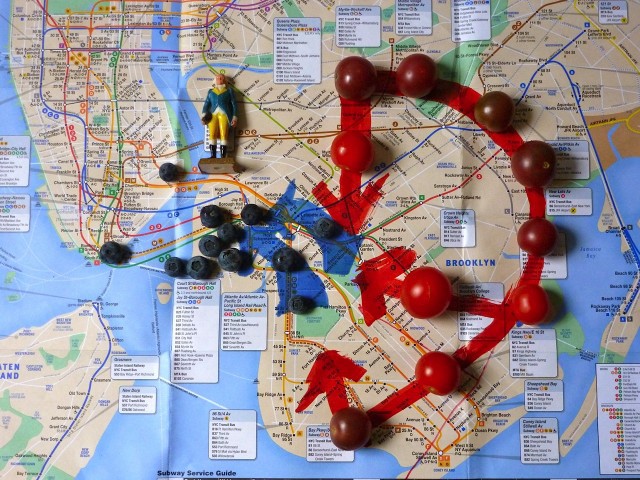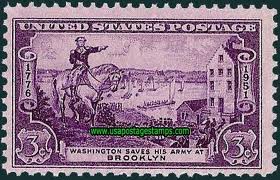The British Invasion... Again: The Battle Begins
The British Invasion… Again: The Battle Begins
by Robert Sullivan

Day four in a series exploring how the trail of the Battle of Brooklyn would pass across modern-day New York. In photo here, the blueberries represent the American side, the cherry tomatoes, the British.
You don’t hear a lot of Monday-morning quarterbacking as far as the Battle of Brooklyn goes. The battle was a loss, but let’s face it: the odds were never good for the Continental Army, and there are not a lot of ways it could have played differently. Sure, there was a general who got sick and had to be replaced at the last minute on the American side, and maybe that was a factor; there were also numerous points at which Americans were asleep at their posts, either literally or figuratively. But even if Washington had managed to win (or not lose), he’d likely have been beaten out of New York eventually, anyway, as he was by fall. Things would not look at all promising for the American side until Christmas, when Washington crossed the Delaware. Another reason you don’t hear a lot of Monday morning quarterbacking is because not a lot of people care. Like I said, it was a loss, as opposed to a glorious victory.
But the actual battle began on this day in 1776, five days after the British landing, and it began with watermelons. The British and the Americans skirmished in the dark in a watermelon patch, where British soldiers were eating, yes, watermelon. (The watermelon patch was planted next to a tavern that, according to historian John Gallagher, was frequented by tourists who came to the spot to see a large rock that was said to resemble the devil’s footprint, a rock that has since gone missing.) Why were the soldiers eating watermelon? Because watermelon was, as now, in season, though if you factor in climate change ours might be in season a little earlier now. Remembering the Revolution is, if you ask me, all about the seasons.
Let’s look at a subway map to get our bearings on where this all went down. In terms of the subway, Washington and his troops were, roughly put, in the area of the F Train stops at Fort Hamilton Parkway and 7th Avenue, in Park Slope and Sunset Park. The British began marching the night before, and they headed down Kings Highway, along a road running north through Brooklyn that is still called Kings Highway. One group took a left at Broadway Junction , where today you could change for the J,Z, A, C and L lines. Those Redcoats headed straight for the village of Bedford, which is today very hip. The other group took a left at Flatbush Avenue, to surprise the Americans by coming through the backside of the woods that are today woods called Prospect Park. A gun was fired by the Redcoats when they arrived in Bedford.

You can walk these roads today — the city turns out to be really good at preserving old human paths (think Broadway, a former trail of the Manhattan Lenape tribe called Wickquasgeck), and when walk you walk Kings Highway early on a summer morning, and you get to the intersection of Kings Highway and Flatbush, you feel as if an army might have turned left here. You just do, trust me. But in terms of artistic representations, things are limited. There are a few plaques in Prospect Park, but there is no great painting, a la Emanuel Leutze’s “Washington Crossing the Delaware” at the Met. In the 1950s, a Brooklyn historian had an artist from the Brooklyn Eagle draw up a kind of imitation Leutze, and after years of fighting, got it made into a Battle of Brooklyn stamp, in 1951. It shows Washington seated on a horse in Brooklyn Heights, pointing the way forward, and features the inscription, “Washington Saves His Army.” The Battle of Brooklyn-related plaque I miss the most was in Red Hook Lane, on Fulton Mall. The plaque is not only gone; the city recently delisted the street. Red Hook Lane, officially speaking, no longer exists.
Some Battle of Brooklyn reenactments happened over the weekend, but they’re over now. And reenactments are hit or miss for me; they can feel a little stiff, depending on my mood. So I did what I have often done in the past to commemorate the event, which was head down to the Gowanus Canal, and scout it. I started at the top of a little hill, on 3rd Street in Carroll Gardens. I stood there. I looked at this sky this morning, summer morning clouds, perhaps the sort of clouds that appeared then. I imagined running down the slope that is Park Slope, through the marsh that became a polluted canal, and up into Brooklyn Heights. Even with pavement, it’s a slog. It’s a long walk, even if you are not being chased by a British army. You can still feel the little valley. And note: all across the land that became the United States of America, where there were once large, oyster-laden marshes, like the Gowanus Marsh that is now down to the impounded Gowanus Canal, there are now factories, industrial sites, sports arenas, airports and polluted creeks.
Then tonight, I’m heading to a dance performance — a reenactment of the battle with movement, with humans addressing the space. It starts at 7 p.m., and will take place at the head of the still visible (especially if you are coasting on a bike) Gowanus valley, at the F Train’s Bergen street stop. It was choreographed by Paul Benney, a dancer, and a member of iLand, a collaboration of dancers and scientists. I’ll also eat some watermelons, and have some of the last tomatoes of the season for lunch. The blueberries are getting tired, like Continental soldiers about now — they had lost the Battle of Brooklyn by lunch. I need a lot of energy, to get ready for the evacuation that’s happening 236 years ago tonight. After that I’ll head down to the harbor, to keep an eye on the water watching it closely, for signs.
Previously: The Landing In New York, Scouting Old Locations and The General And The Moose
Robert Sullivan is the author of a several books, including Rats, How Not To Get Rich, and the Meadowlands. His newest book My American Revolution will be published Sept. 4 and is available for preorder.
